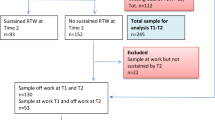Abstract
Objectives To evaluate the ability of a short-form FCE to predict future timely and sustained return-to-work. Methods A prospective cohort study was conducted using data collected during a cluster RCT. Subject performance on the items in the short-form FCE was compared to administrative recovery outcomes from a workers’ compensation database. Outcomes included days to claim closure, days to time loss benefit suspension and future recurrence (defined as re-opening a closed claim, restarting benefits, or filing a new claim for injury to the same body region). Analysis included multivariable Cox and logistic regression using a risk factor modeling strategy. Potential confounders included age, sex, injury duration, and job attachment status, among others. Results The sample included 147 compensation claimants with a variety of musculoskeletal injuries. Subjects who demonstrated job demand levels on all FCE items were more likely to have their claims closed (adjusted Hazard Ratio 5.52 (95% Confidence Interval 3.42–8.89), and benefits suspended (adjusted Hazard Ratio 5.45 (95% Confidence Interval 2.73–10.85) over the follow-up year. The proportion of variance explained by the FCE ranged from 18 to 27%. FCE performance was not significantly associated with future recurrence. Conclusion A short-form FCE appears to provide useful information for predicting time to recovery as measured through administrative outcomes, but not injury recurrence. The short-form FCE may be an efficient option for clinicians using FCE in the management of injured workers.

Similar content being viewed by others
References
Soer R, van der Schans CP, Groothoff JW, Geertzen JH, Reneman MF. Towards consensus in operational definitions in functional capacity evaluation: a Delphi Survey. J Occup Rehabil. 2008;18:389–400.
King PM, Tuckwell N, Barrett TE. A critical review of functional capacity evaluations. Phys Ther. 1998;78:852–66.
Isernhagen SJ. Functional capacity evaluation: rationale, procedure, utility of the kinesiophysical approach. J Occup Rehab. 1992;2:157–68.
Lackner JM, Carosella AM. The relative influence of perceived pain control, anxiety, and functional self efficacy on spinal function among patients with chronic low back pain. Spine. 1999;24:2254–60. (discussion 60-1).
Gross DP, Battié MC. Functional capacity evaluation performance does not predict sustained return to work in claimants with chronic back pain. J Occup Rehabil. 2005;15:285–94.
Gross DP, Battié MC, Cassidy JD. The prognostic value of functional capacity evaluation in patients with chronic low back pain: part 1: timely return to work. Spine. 2004;29:914–9.
Gross DP, Battié MC. The prognostic value of functional capacity evaluation in patients with chronic low back pain: part 2: sustained recovery. Spine. 2004;29:920–4.
Streibelt M, Blume C, Thren K, Reneman MF, Mueller-Fahrnow W. Value of functional capacity evaluation information in a clinical setting for predicting return to work. Arch Phys Med Rehabil. 2009;90:429–34.
Soer R, Groothoff JW, Geertzen JH, van der Schans CP, Reesink DD, Reneman MF. Pain response of healthy workers following a functional capacity evaluation and implications for clinical interpretation. J Occup Rehabil. 2008;18:290–8.
Reneman MF, Kuijer W, Brouwer S, et al. Symptom increase following a functional capacity evaluation in patients with chronic low back pain: an explorative study of safety. J Occup Rehabil. 2006;16:197–205.
Gross DP, Battié MC, Asante AK. Evaluation of a short-form functional capacity evaluation: less may be best. J Occup Rehabil. 2007;17:422–35.
Gross DP, Battié MC, Asante A. Development and validation of a short-form functional capacity evaluation for use in claimants with low back disorders. J Occup Rehabil. 2006;16:53–62.
Tait RC, Chibnall JT, Krause S. The Pain Disability Index: psychometric properties. Pain. 1990;40:171–82.
Chibnall JT, Tait RC. The Pain Disability Index: factor structure and normative data. Arch Phys Med Rehabil. 1994;75:1082–6.
Finch E, Brooks D, Stratford P, Mayo N. Physical rehabilitation outcome measures: a guide to enhanced clinical decision making. 2nd ed. Toronto: Canadian Physiotherapy Association; 2002.
Hosmer DW, Lemeshow S. Applied survival analysis: regression modeling of time to event data. 1st ed. New York: Wiley; 1999.
Nemes S, Jonasson JM, Genell A, Steineck G. Bias in odds ratios by logistic regression modelling and sample size. BMC Med Res Methodol. 2009;9:56.
Wasiak R, Verma S, Pransky G, Webster B. Risk factors for recurrent episodes of care and work disability: case of low back pain. J Occup Environ Med. 2004;46:68–76.
Wasiak R, Pransky GS, Webster BS. Methodological challenges in studying recurrence of low back pain. J Occup Rehabil. 2003;13:21–31.
Reneman MF, Dijkstra PU, Westmaas M, Goeken LN. Test-retest reliability of lifting and carrying in a 2-day functional capacity evaluation. J Occup Rehab. 2002;12:269–75.
Gross DP, Battié MC. Reliability of safe maximum lifting determinations of a functional capacity evaluation. Phys Ther. 2002;82:364–71.
Gouttebarge V, Wind H, Kuijer PP, Frings-Dresen MH. Reliability and validity of functional capacity evaluation methods: a systematic review with reference to Blankenship system, Ergos work simulator, Ergo-Kit and Isernhagen work system. Int Arch Occup Environ Health. 2004;77:527–37.
van Ittersum MW, Bieleman HJ, Reneman MF, Oosterveld FG, Groothoff JW, van der Schans CP. Functional capacity evaluation in subjects with early osteoarthritis of hip and/or knee; is two-day testing needed? J Occup Rehabil. 2009;19:238–44.
Acknowledgments
This project was completed in partial fulfillment of MScPT degree requirements for the first four authors. The Workers’ Compensation Board—Alberta/Millard Health facilitated data collection. Dr. Battié is supported by the Canada Research Chairs Program.
Author information
Authors and Affiliations
Corresponding author
Rights and permissions
About this article
Cite this article
Branton, E.N., Arnold, K.M., Appelt, S.R. et al. A Short-Form Functional Capacity Evaluation Predicts Time to Recovery but Not Sustained Return-to-Work. J Occup Rehabil 20, 387–393 (2010). https://doi.org/10.1007/s10926-010-9233-9
Published:
Issue Date:
DOI: https://doi.org/10.1007/s10926-010-9233-9




